
Liberty ships were a class of cargo ship built in the United States during World War II under the Emergency Shipbuilding Program. Though British in concept, the design was adopted by the United States for its simple, low-cost construction. Mass-produced on an unprecedented scale, the Liberty ship came to symbolize U.S. wartime industrial output.

SS Edmund Fitzgerald was an American Great Lakes freighter that sank in Lake Superior during a storm on November 10, 1975, with the loss of the entire crew of 29 men. When launched on June 7, 1958, she was the largest ship on North America's Great Lakes, and she remains the largest to have sunk there. She was located in deep water on November 14, 1975, by a U.S. Navy aircraft detecting magnetic anomalies, and found soon afterwards to be in two large pieces.

The SS William G. Mather is a retired Great Lakes bulk freighter now restored as a museum ship in Cleveland, Ohio, one of five in the Great Lakes region. She transported cargo such as ore, coal, stone, and grain to ports throughout the Great Lakes, and was nicknamed "The Ship That Built Cleveland" because Cleveland's steel mills were a frequent destination.

Lake freighters, or lakers, are bulk carrier vessels that operate on the Great Lakes of North America. These vessels are traditionally called boats, although classified as ships.

Col. James M. Schoonmaker, formerly Willis B. Boyer, is a lake freighter that served as a commercial vessel on the Great Lakes for much of the 20th century. Named for Medal of Honor recipient James Martinus Schoonmaker, it is currently a museum ship in Toledo, Ohio.
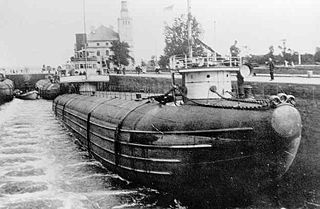
The Thomas Wilson was a whaleback freighter built in 1892 and used to haul bulk freight on the Great Lakes. The ship sank in Lake Superior just outside the harbor of Duluth, Minnesota, United States, on 7 June 1902, after a collision with the George Hadley. The wreck of the Thomas Wilson is one of the best remaining examples of a whaleback steamer, and it is also significant for the changes made in operating procedures at the Duluth harbor. The remains of the ship were listed on the National Register of Historic Places in 1992.
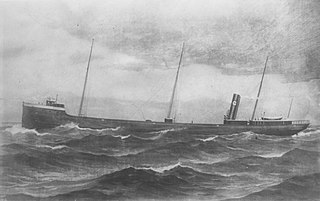
W.H. Gilcher was a steam lake freighter built in 1890–1891 by Cleveland Shipbuilding Company of Cleveland for Gilchrist, Gilcher & Schuck of Sandusky, with intention of transporting cargo between various ports located on Great Lakes. The ship was named after William H. Gilcher, one of the owners of the company. In October 1892 the freighter ran into a strong gale on Lake Michigan and foundered with the loss of eighteen men.
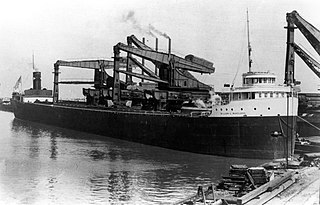
SS William C. Moreland was a 600-foot (180 m) long Great Lakes freighter that ran aground on Sawtooth Reef, Lake Superior on 18 October 1910, only a month after entering service. Visibility was poor due to the smoke from several forest fires, causing the William C. Moreland to ran full steam onto a reef. There were many attempts to salvage the ship, but eventually only the 278-foot (85 m) long stern was salvaged and was used to build the 580-foot (180 m) long Sir Trevor Dawson.

SS Amasa Stone was a 545-foot (166 m) Great Lakes freighter that was sunk as a breakwater in 1965, Charlevoix, Michigan. She was built for the Mesaba Steamship Company by the Detroit Shipbuilding Company of Wyandotte, Michigan. She was launched on March 25, 1905, as hull #158. She was powered by an 1,800-horsepower (1,300 kW) triple expansion steam engine and two scotch marine boilers.

Augustus B. Wolvin was a 560 ft (170 m) long Great Lakes freighter that had a 63-year career on the Great Lakes. Augustus B. Wolvin was a product of the American Shipbuilding Company of Cleveland, Ohio. She was built for the Acme Steamship Company of Duluth, Minnesota.

SS B.F. Jones was a steel-hulled Great Lakes freighter that was named after one of the founders of the Jones and Laughlin Steel Company. She was launched on December 30, 1905 as hull #15. She operated from April 1906 to August 21, 1955 she collided with the steamer Cason J. Callaway. After inspection she was declared a constructive total loss, and scrapped in Duluth, Minnesota.

SS Onoko was an iron hulled Great Lakes freighter. She was launched in 1882 in Cleveland, Ohio as hull number #4, and sank on September 14, 1915 in Lake Superior near Knife River, Minnesota. Onoko is thought to be the prototype for every single steel hulled Great Lakes Bulk carrier that ever sailed. These vessels made possible the cheap transport of bulk cargoes such as iron ore, coal and limestone. Her wreckage still remains on the bottom of Lake Superior and was listed on the National Register of Historic Places in 1992.

The Henry Phipps was a 601-foot-long (183 m) American Great Lakes freighter that served on the Great Lakes of North America from her launching in 1907 to her scrapping in 1976 by Hyman Michaels Company of Duluth, Minnesota. The Phipps was used to haul bulk cargoes such as iron ore, coal, grain and occasionally limestone.

Algoma Provider was a Canadian lake freighter, which operated from 1963 to 2013 under the flag of several shipping lines. She was built to seawaymax dimensions at the Collingwood Shipyards in Collingwood, Ontario for Canada Steamship Lines. She was powered by a steam turbine, and was the company's last steam-powered vessel. Initially named Murray Bay, the ship was sold in 1994 to Upper Lakes Shipping, which renamed the vessel Canadian Provider. In 2011, Upper Lakes Shipping sold its entire fleet to Algoma Central, which renamed the lake freighter Algoma Provider. The vessel continued in service until 2013, when she was sold to be broken up for scrap. The ship was renamed Ovi for her journey to the scrapyard in Turkey. During her career, the ship carried bulk cargoes to destinations along the Saint Lawrence Seaway and Great Lakes.

The MV Kaye E. Barker is a self-discharging lake freighter owned and operated by the Interlake Steamship Company. She was originally built as the Edward B. Greene, and was later renamed Benson Ford before being sold to Interlake and named the Barker. It primarily hauls hematite pellets, stone, and coal across the North American Great Lakes.
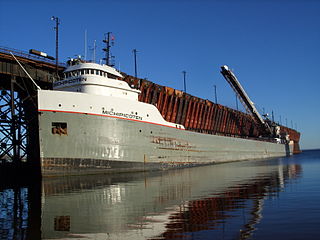
Michipicoten is a self-discharging lake freighter owned and operated by Canadian shipping firm Lower Lakes Towing. Michipicoten primarily hauls taconite from Marquette, Michigan, to the Algoma Steel Mill in Sault Ste. Marie, Ontario. It has a capacity of 22,300 tons, a speed of 12 knots (14 mph), and a length of 689 feet 6 inches (210.2 m).
Lake Frampton was a steam cargo ship built in 1918 by American Shipbuilding Company of Lorain for the United States Shipping Board (USSB) as part of the wartime shipbuilding program of the Emergency Fleet Corporation (EFC) to restore the nation's Merchant Marine. The vessel was employed in coastal trade during her career and collided with another steamer, SS Comus, and sank in July 1920 on one of her regular trips with a loss of two men.
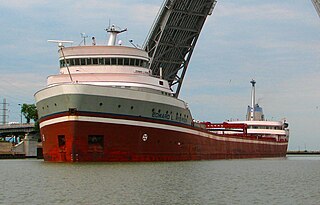
SS Edward L. Ryerson is a steel-hulled American Great Lakes freighter that entered service in 1960. Built between April 1959 and January 1960 for the Inland Steel Company, she was the third of the thirteen so-called 730-class of lake freighters, each of which shared the unofficial title of "Queen of the Lakes" because of their record-breaking length. She was not only the last steam-powered freighter built on the lakes but also the last one that was not a self-unloader. Since 2009, she has been in long-term layup in Superior, Wisconsin. She is one of only two American-owned straight deck lake freighters, the other being John Sherwin, built in 1958.

MV Mark W. Barker is a large diesel-powered lake freighter owned and operated by the Interlake Steamship Company. She is the first of the River-class freighters constructed for an American shipping company. MV Mark W. Barker is the first ship on the Great Lakes to be powered with engines that meet EPA Tier 4 standards.
























